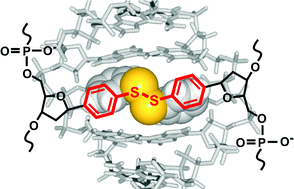Solution structure of S-DNA formed by covalent base pairing involving a disulfide bond†
Abstract
Here, we present the solution structure of a DNA duplex containing a

* Corresponding authors
a
Department of Chemistry, Shibaura Institute of Technology, 307 Fukasaku, Minuma-ku, Saitama, Japan
E-mail:
a-hatano@sic.shibaura-it.ac.jp
Fax: +81-48-687-5013
Tel: +81-48-687-5035
b Department of Life and Environmental Sciences, Faculty of Engineering, Chiba Institute of Technology, 2-17-1 Tsudanuma, Narashino, Chiba 275-0016, Japan
Here, we present the solution structure of a DNA duplex containing a

 Please wait while we load your content...
Something went wrong. Try again?
Please wait while we load your content...
Something went wrong. Try again?
A. Hatano, M. Okada and G. Kawai, Org. Biomol. Chem., 2012, 10, 7327 DOI: 10.1039/C2OB25346A
To request permission to reproduce material from this article, please go to the Copyright Clearance Center request page.
If you are an author contributing to an RSC publication, you do not need to request permission provided correct acknowledgement is given.
If you are the author of this article, you do not need to request permission to reproduce figures and diagrams provided correct acknowledgement is given. If you want to reproduce the whole article in a third-party publication (excluding your thesis/dissertation for which permission is not required) please go to the Copyright Clearance Center request page.
Read more about how to correctly acknowledge RSC content.
 Fetching data from CrossRef.
Fetching data from CrossRef.
This may take some time to load.
Loading related content
